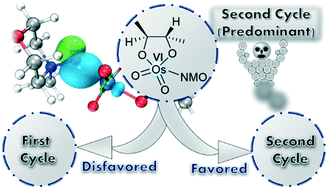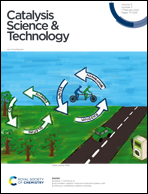Predominance of the second cycle in homogeneous Os-catalyzed dihydroxylation: the nature of Os(vi) → Os(viii) reoxidation and unprecedented roles of amine-N-oxides†
Abstract
The homogeneous Os-catalyzed dihydroxylation of alkenes has been widely applied in organic synthesis. Mechanistic studies on the diol formation have been performed but concentrated on the osmylation step to form Os(VI) glycolate; however, the details and the origin of the reactivity of the catalytic cycle that comprises several mechanistically poorly defined steps have yet to be fully understood. Here, we report density functional theory (DFT) investigations of the Os-catalyzed non-enantioselective dihydroxylation of trans-butene under homogeneous conditions (OsO4/NMO) to demonstrate the predominant pathway to be through a second cycle, with the reoxidation of Os(VI) glycolate outpacing its hydrolysis. The putative Os(VIII) trioxoglycolate is found as a highly reactive intermediate that undergoes a highly rapid osmylation of another alkene, initiating the second cycle. The present study shows that tertiary amines like NMM, the oxidation coproduct, do not promote either reoxidation or hydrolysis of Os(VI) glycolate but inhibit the reaction by competing coordination. Utilizing the energetic span model on our proposed computed catalytic cycle, reoxidation of Os(VI) → Os(VIII) glycolate is found to be the turnover-limiting state. The hydrolysis of Os(VI) bisglycolate, formed by the second osmylation reaction, is catalyzed by NMM through a stepwise ion-pairing mechanism. In addition to the reoxidation role played by NMO, it plays another role by catalyzing the hydrolysis of the stable Os(VI) bisglycolate either through the coproduct base NMM or by NMO-assisted stabilization of the stepwise ion-pairing hydrolysis of Os(VI) bisglycolate. Besides, the reoxidation step Os(VI) → Os(VIII), with and without NMM, is studied in detail by combining localized and principal interacting orbital and distortion/interaction analysis. The findings presented in this work will encourage experimentalists to implement further studies on Os catalysis to design a more efficient catalytic version that tackles enantioselective deficiencies in the 1,2-diol formation and even in oxidative cyclization of 1,5-dienes to give tetrahydrofuran diols.



 Please wait while we load your content...
Please wait while we load your content...